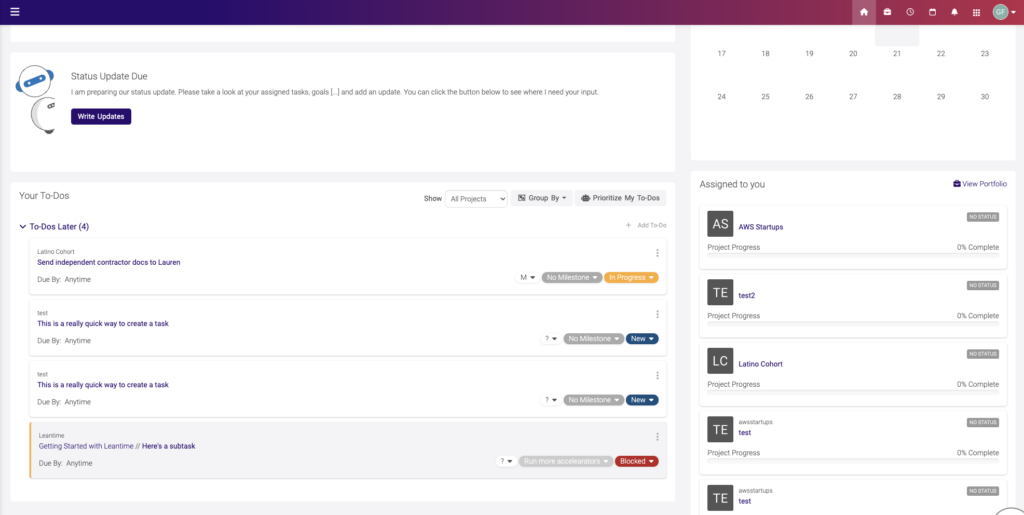Boost Your Productivity with Effective Task Management Strategies

Estimated reading time: 18 minutes
Key Takeaways
- Task management is essential for optimizing productivity and ensuring successful collaboration, organization, communication and task prioritization.
- Strategies such as setting clear goals & objectives, prioritizing tasks efficiently with the Goldilocks Method or Pareto Principle and breaking down large tasks into smaller parts can help to maximize productivity.
- Overcoming common challenges like procrastination, distractions/interruptions & burnout require utilizing task management tools in combination with self care practices.
In the ever-evolving world of work, managing tasks effectively is key to boosting productivity and achieving desired outcomes. But how can you optimize this process to ensure success? The answer lies in utilizing effective task management strategies and tools designed to help individuals and teams stay organized, prioritize, and delegate tasks efficiently. Read on to discover how you can enhance your productivity through proven task management techniques and with the right task management software options and solutions.
Table of contents
Understanding Task Management

Task management is the backbone of a successful project, allowing you to create task assignments to maximize your team’s potential and achieve your organizational goals. Strategic approaches and quality task management software can aid in task management, team member assignment, and easy tracking of project progress.
As we’ve begun to add team members to the party here at Leantime, I find that we’re stopping to talk more and more about our startup culture. We’re deciding what Leantime looks like on the inside. New team members can make or break your current culture and change the way the team relates.
We’re in the business of efficient planning – thinking about culture before it grows out of hand is part of managing and structuring a startup into a company and a profitable business. These early stages set the tone and inertia of the company and it will happen whether or not you’ve paid any attention to it. It’s the seed that is planted and one day, you go to water it and it’s already a sprout.
When culture develops without being nurtured, however, it’s possible to end up with a culture that you didn’t want, intend, or one that ruins all the organization’s hard work.
Read More: Startup Project Management: The Key to Success
So what’s a startup to do? Great question! Welcome to our cliche-ly titled blog. Here you will find some basic things to consider when both keeping your culture in check and in starting one.
1. What sucked about the culture in your last job(s)?
Remember all those things your parents did that you said if you ever had kids, you wouldn’t do? Same thing. Maybe you didn’t mind working for someone else all that much but often, you’re an entrepreneur for a reason. Make a list; what were the qualities of the people that sucked? What about management sucked? Was it chaotic and disorganized? It’s a startup; some of that is inevitable. Figure out what you can control and start cleaning house.
2. Adult Conversations
Do you remember that one relationship you were in where your partner, in a fight, constantly said the same thing over and over again? The fight never ends! I think of work relationships like romantic ones. They take good, strong, adult conversations. If your team, customers, or partners are complaining about the same thing over and over again… it’s because 1. You haven’t validated their feelings. and 2. you likely haven’t changed anything.
Some problems can be solved at the first point. Take a moment; do some active listening. From there, evaluate their point – do you need to do more? Can you do more? Unfortunately, some folks aren’t ready for adult conversations. At that point, if you’ve done what you can — you’ve done your part in creating and maintaining a respectful culture.
3. Communication
What’s the feedback process? Here at Leantime, we want to do more than say “we have an open door policy.” In fact, we’ll probably be the first ones to ask you an awkward question about how you really feel about something. If you aren’t sure what this looks like, take a gander at Crucial Conversations. If you don’t know, you can’t fix it. Ignorance never prompts change.
4. Change, change, change
That brings up this point — don’t be afraid to keep moving. As a startup, you should be used to moving. Constantly changing, being lean, iterating your product over and over. You are likely the least change averse; but what happens when we’re moving? We forget details; we forget to build the culture and it ends up building itself. If you don’t tend to the garden, eventually you end up overrun with weeds. Culture will need to change with the company and the product.
5. Are you the problem?
Have you defined your leadership style? Is it clear to everyone else? Are you a baby Steve Jobs and running over the people trying to help you achieve your dreams? If people aren’t leaving yet, they will be. Go back to #2. It’s time for an adult conversation with yourself.
Problem. Solution. Fit. doesn’t just have to be about customer acquisition and building your business. This is an idea that works with people — you’ve identified a pain point, you have a great solution and it fits the problem — now you need to find and foster the team that fits within your culture, your company, and your business. Having a great idea is important but the great team? That can make the difference between unicorn and failure.
How do you define the culture within your organization?
Grasping the core concepts and importance of effective task management is key to leveraging its power.
What is Task Management?
At its core, task management is the process of organizing, prioritizing, and tracking tasks to ensure goals are achieved effectively. Task management software significantly aids in task assignment, tracking, and organization within larger projects. These tools typically offer features such as time tracking and task and project management capabilities, ensuring nothing is overlooked and helping to monitor project progress.
One of the benefits of using a task management tool is the ability to:
- Break down larger projects into smaller components or subtasks
- Make tasks more manageable
- Assess progress and identify areas that require more attention
- Capture, assign, and organize tasks to highlight inefficiencies, bottlenecks, and redundancies that require attention
The best task management software can help you manage tasks effectively across multiple projects, making it one of the best task management tools available. With good task management software, especially free task management software, you can experience these benefits without any financial investment. Task management apps also provide a convenient way to access these tools on the go. By using a visual task management app or tool as part of your task management solution, you can streamline your work process and increase productivity.
An organized task list aids in completing multiple tasks, provides assurance and helps track task progress. With a range of features available in task management software, such as customizable task tracker templates and collaboration tools, it’s easier than ever to stay organized and focused on your goals.
Read More: How to Focus Better: Top Strategies That Work
Why is Task Management Important?
Task management is key for organization, effective time management and enhanced productivity. Some benefits of using task management software include:
- Improved task organization and prioritization
- Enhanced project management
- Better collaboration and communication
- Real-time task tracking
- Streamlined workflows
Task prioritization is another key aspect of task management. The Pareto Principle, for example, emphasizes focusing on the 20% of tasks that will yield 80% of the results. You can maximize your productivity and achieve the most impactful results by identifying and prioritizing high-value tasks.
Moreover, utilizing simple task management software tools can help individuals with ADHD maintain organization, prioritize tasks, and manage time more productively. As a result, task management software helps plays a significant role not only in improving productivity but also in supporting the diverse needs of team members.
Strategies for Effective Task Management

A clear strategy is required for effective task management. This includes setting goals and objectives, prioritizing tasks, and breaking down large tasks into smaller, manageable parts. With the right approach, you can optimize your task management process, increase productivity, and achieve better results.
The following sections outline strategies for enhancing task management, encompassing goal setting, task prioritization and task breakdown into smaller components. Let’s dive into these techniques that, when combined, can set the stage for success.
Setting Clear Goals and Objectives
Setting clear goals and objectives provides direction and focus, and is a vital element of task management. Establishing goals and objectives is integral to productivity and success, as clarity and focus provide individuals and teams with a clear direction and focus on what needs to be achieved. This clarity eliminates distractions and allows for better task prioritization, resulting in increased productivity.
Specific, measurable, achievable, relevant, and time-bound (SMART) goals and objectives can help you create a roadmap for achieving your objectives. This structured approach to task management enhances productivity and increases the likelihood of success. By setting specific targets, individuals and teams can monitor their progress and hold themselves accountable for achieving the desired outcomes.
Some examples of clear goals and objectives in task management include:
- Enhancing communication and collaboration among team members
- Improving productivity and performance in completing tasks
- Achieving specific project milestones and deliverables
- Reducing project scope creep
By defining and pursuing these goals, you can ensure that your task management efforts are focused and effective.
Prioritizing Tasks
Task prioritization is a vital component of effective task management. Two popular methods for prioritizing tasks include the Goldilocks Method and the Pareto Principle. The Goldilocks Method involves finding the right balance or ‘just the right amount’ of tasks to focus on, selecting tasks that are neither too simple nor too complex, but create tasks that are stimulating enough to maintain motivation and engagement.
On the other hand, the Pareto Principle emphasizes focusing on the 20% of tasks that will yield 80% of the results. By identifying and prioritizing high-value tasks, you can maximize your productivity and achieve the most impactful results. Both of these methods can help ensure that your time and resources are used efficiently, ultimately leading to more effective task management.
To implement these methods, start by:
- Breaking down large tasks into smaller, more manageable tasks
- Setting deadlines
- Creating a timeline for completion
- Prioritizing tasks based on importance and urgency
By employing these prioritization strategies, you can make task priorities and ensure an effective utilization of time and resources.
Breaking Down Large Tasks
Breaking down large tasks into smaller, more manageable ones aids task management by simplifying progress assessment and identifying areas needing more attention. Furthermore, it can help to alleviate stress and make it simpler to remain on track. By dividing tasks into smaller parts, you can make the work more manageable and less intimidating, optimizing productivity and ensuring that efforts are aligned with the desired results.
The psychological advantages of dividing large tasks into smaller ones include:
- Decreased feelings of overwhelm
- Increased motivation
- Heightened focus and concentration
- Improved planning and organization
Recognizing and utilizing the diverse personalities within a team can lead to team collaboration, more effective task performance and improved team dynamics.
By employing techniques such as breaking down tasks into smaller parts, setting deadlines, and focusing on the benefits of completing the task, you can overcome common task management challenges such as procrastination, distractions, and burnout. These strategies, combined with the use of effective task management tools, can help ensure that your tasks are managed efficiently and effectively.
Choosing the Right Task Management Tool

Choosing an appropriate task management tool is key to streamline your task management process and ensure timely task completion. With so many options available, it’s important to consider each tool’s features, integrations, and user experience to find the best fit for your needs.
The following sections outline the essential features to consider when selecting a task management tool and provide an overview of some popular options currently on the market. By understanding each project management tool’s unique features and benefits, you can make an informed decision and choose the one that best suits your task management requirements.
Features to Look For
When selecting a task management tool, it’s important to consider key features, such as:
- Collaboration capabilities, such as task lists and task management capabilities, calendar views, file attachments, real-time messaging or chat functionality, and integration with other tools or software
- Prioritization features to help you prioritize tasks and stay organized
- Customization capabilities to tailor the tool to your specific needs
These features can help ensure that your team stays organized and on track with their tasks.
Prioritization features, such as the ability to assign tasks and subtasks and set deadlines, can help ensure that your team focuses on the most important tasks first. Customization capabilities, such as customizable views, list templates, and reporting features, can help you tailor the tool to your specific needs and preferences.
By considering these essential features, along with factors such as ease of use, scalability, and pricing, you can find a great task management software or tool that will help you optimize your task management and achieve your goals.
Popular Task Management Tools
Several popular task management tools are on the market, each with unique features and benefits. Some of these tools include Leantime.io, Asana, Evernote, Todoist, and Due.
Leantime.io is one of the best task management platform with its open-source platform and cloud based options; designed for non-project managers and built with cognitive accessibility, neurodivergence, and ADHD in mind. Allowing you to manage projects effectively alongside tasks, it also includes the following features:
- Multiple task views
- Time tracking
- Subtasks
- Project dashboard
- Built-in retrospectives
- Role management
- Business processes and business development
- And many others

Leantime also incorporates principles of behavioral science and motivational psychology alongside its use of AI. With Leantime’s “LEO” AI, you can now have your individual tasks prioritized automatically based on the above mentioned productivity principles such as the Goldilocks method and also the Pareto Principle. Lastly, they also offer a free plan with unlimited usage of their core cloud and open source platform.
Asana is another highly regarded SaaS-only project management platform that allows you to track tasks alongside its project management features. It allows individuals to break larger, complex projects down into subtasks and focus on accomplishing one subtask at a time.
By considering the unique features and benefits of each tool, you can choose the task management software that best suits your needs and helps you stay organized, prioritize tasks, and manage time more productively.
Tips for Effective Task Delegation

Effective task delegation is key to optimizing productivity and ensuring timely, high-quality task completion. Here are some steps to follow:
- Assess team members’ skills and abilities.
- Set clear expectations and deadlines for each task.
- Provide ongoing feedback and support. By following these steps, you can ensure that tasks are delegated efficiently and effectively.
This section outlines tips and strategies for effective task delegation, such as assessing your team’s skills and abilities before assigning tasks, setting clear expectations and deadlines, and providing feedback and support.
Assessing Team Members’ Skills and Abilities
Evaluating team members’ skills and abilities in task assignments and delegation is critical, as it facilitates effective and efficient assignment of tasks. By gaining an understanding of each team member’s strengths and weaknesses, tasks can be assigned to those who possess the required skills and knowledge to complete them successfully. This aids in maximizing productivity, enhancing the quality of work, and ensuring tasks are accomplished on schedule.
To assess team members’ skills and abilities, consider administering tests or assessments, gathering feedback from other team members or colleagues, and evaluating the quality of their work products or projects they have completed. Focusing on key competencies such as technical knowledge, problem-solving and critical thinking, communication skills, collaboration and teamwork, and adaptability and flexibility can help you identify each team member’s strengths and areas for improvement.
This is another AI feature coming to Leantime. Through the use of AI task sentiment, you and each team member can privately rate how they feel about each task. It will then take your feelings into consideration as it prioritizes; the next phase of this, however, will be supporting the assignment of tasks based on team member interest and abilities.
By recognizing and utilizing the diverse personalities within a team, you can ensure that tasks are delegated efficiently and effectively, ultimately leading to improved team dynamics and increased productivity.
Setting Expectations and Deadlines
Setting clear expectations and deadlines for task dependencies is key to maintaining accountability and timely task completion. Deadlines play a critical role in task management by establishing clear objectives for task completion, promoting accountability and motivation, and aiding in effective time management.
To set expectations and deadlines to complete tasks, start by breaking down large tasks into smaller, more manageable tasks, setting deadlines, and creating a timeline for completion. This approach can help ensure that your time and resources are used efficiently and that tasks are completed on schedule.
By establishing clear expectations and deadlines for project tasks, you can help to maintain accountability, manage projects, ensure that tasks are completed on time, and prevent potential issues such as delays and unsatisfactory outcomes.
Providing Feedback and Support
Feedback and support are essential for fostering a positive work environment and encouraging continuous improvement. By offering constructive feedback, guidance, and course correction in a respectful manner, you can help team members improve their performance and achieve the desired outcomes.
When providing feedback, it’s important to be positive, objective, specific, actionable, and timely. Additionally, it’s essential to be honest and direct while being mindful when delivering feedback. Offering support and guidance throughout the task management process can help team members feel more confident and better equipped to handle challenges, ultimately resulting in increased productivity and overall success.
By employing these tips for effective task delegation, you can optimize your task management process, ensure that tasks are completed on time and to the highest standard, and foster a positive and productive work environment.
Overcoming Common Task Management Challenges

Despite having effective task management strategies, challenges such as procrastination, distractions, and burnout are common. This section outlines methods to overcome common task management challenges and sustain productivity.
By employing techniques such as:
- breaking tasks into smaller parts
- setting deadlines
- focusing on the benefits of completing the task
- using task management tools
You can overcome these challenges and ensure that your tasks are managed efficiently and effectively.
Procrastination
Procrastination can significantly hinder effective task management. By breaking tasks into smaller parts, setting deadlines, and focusing on the benefits of completing the task, you can overcome procrastination and maintain momentum.
Utilizing a focus on the benefits of completing a task can reduce procrastination by altering one’s mindset from short-term gratification to long-term rewards. Some of the positive results and advantages of completing the task include:
- Feeling a sense of accomplishment
- Gaining new skills or knowledge
- Moving closer to achieving goals
- Reducing stress and anxiety
- Improving productivity and efficiency
Identifying these benefits can increase motivation and diminish the inclination to postpone or avoid the task.
By employing these techniques, along with the use of effective online task management software tools, you can overcome procrastination and ensure that your tasks are managed efficiently and effectively.
Distractions and Interruptions

Distractions and interruptions can disrupt productivity and task tracking. Minimizing distractions and interruptions by creating a conducive work environment and using tools like focus mode in Asana can improve task management.
Focus Mode in Asana is a feature designed to allow users to view one task at a time, thereby minimizing distractions from other tasks. By activating Focus Mode, users can concentrate on the task at hand and improve productivity.
By implementing strategies to minimize distractions and interruptions, along with the use of effective task management tools, you can ensure that your tasks are managed efficiently and effectively.
Burnout
Burnout, a common issue in task-heavy environments, can significantly affect productivity and overall well-being. Preventing burnout by prioritizing self-care, setting realistic expectations, and delegating tasks effectively ensures sustainable productivity.
Mitigating burnout in a task-heavy environment may involve:
- Reducing exposure to job stressors
- Prioritizing self-care
- Setting achievable goals and expectations
- Taking regular breaks
- Seeking support and connection
By employing these strategies, along with the use of effective task management tools, you can overcome burnout and maintain a healthy, productive work environment.
Summary
In conclusion, effective task management is essential for boosting productivity and achieving desired outcomes. By understanding the importance of task management, employing strategic approaches, and utilizing the right task management software tools, you can optimize your task management process and ensure success. Remember to set clear goals and objectives, prioritize tasks, delegate effectively, and overcome common challenges such as procrastination, distractions, and burnout. With the right strategies and tools in place, you can enhance your productivity and achieve your goals.
Frequently Asked Questions
Task management is the process of managing a task through its lifecycle, from start to finish. It involves actively doing recurring tasks, making decisions for your tasks to accommodate changes that can occur real-time, and monitoring progress to ensure successful completion. Task management can help either individual achieve goals, or groups of individuals collaborate and share knowledge for the achievement of collective goals.
Task management involves a task manager breaking down a larger project into smaller steps to track progress toward its completion. Examples include making coffee, shopping lists, and even creating schedules.
A task management system is an effective way to organize and prioritize tasks in order to efficiently complete projects, whether it be through spreadsheets or online project management software applications.
Popular task management tools on the market include Leantime.io, Asana, Evernote, Todoist and Due.
Task management software can help overcome procrastination by breaking down larger tasks into smaller, manageable ones, setting deadlines and focusing on the benefits of completing the task.
Here are some other articles you may be interested in




